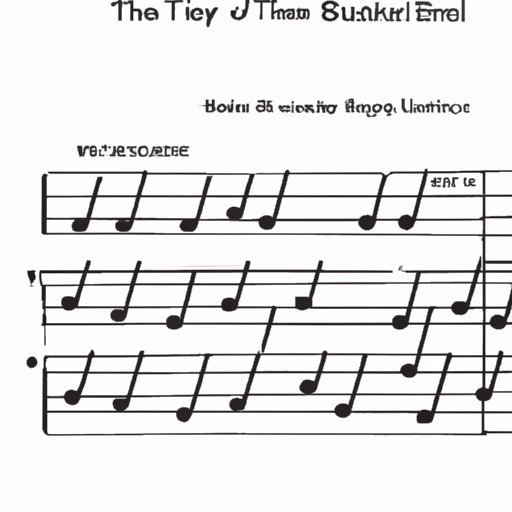Introduction
If you’ve ever played an instrument or sung in a choir, you’ve most likely heard the term “bar” thrown around quite often. Bars are crucial elements of music, but not everyone understands what they are or how they work. In this guide, we’ll provide a comprehensive overview of bars in music to help you better understand and appreciate this important element of music theory.
The Ultimate Guide to Understanding Bars in Music
Before diving into the specifics of bars in music, it’s important to define what it is. Simply put, a bar is a segment of music that is separated by vertical lines on sheet music, indicating a boundary that separates it from the rest of the piece. A bar is also referred to as a “measure.”
The length of a bar is determined by the time signature of a piece of music. Time signatures, represented by two numbers stacked on top of each other like a fraction, indicate how many beats are in each bar, as well as what kind of note gets the beat. For example, in 4/4 time, there are four beats in each bar, and a quarter note gets one beat.
Bars are used in a variety of genres of music and are essential for establishing rhythm and timing in a piece of music. Let’s explore how bars are used in different genres and how they relate to time signatures.
Breaking Down Musical Bar Structures: A Beginner’s Guide
There are different types of bar structures commonly used in music, and each has its own unique feel and rhythmic pattern.
4/4 time, sometimes referred to as “common time” or “rock time,” is the most common time signature, with four beats per bar. It’s used in most popular music genres, including pop, rock, and country.
3/4 time, often used in waltzes, has three beats per bar, with each beat lasting a quarter note. It’s known for its flowing, lilting feel and can evoke a sense of elegance and grace.
6/8 time, used in many Latin and African music styles, has six beats per bar, with each beat lasting an eighth note. It’s known for its fast-paced, driving feel.
Bars are written in sheet music using vertical lines that separate each bar, and the number of bars per line can vary depending on the piece of music.
Examples of popular songs that use different bar structures include “Sweet Home Alabama” (4/4 time), “The Blue Danube Waltz” (3/4 time), and “Bamboleo” by the Gipsy Kings (6/8 time).
Unpacking the Essentials of Bars and How They Affect Music
Understanding bars is crucial when it comes to understanding how music works.
Bars impact the rhythm of a song, dictating the pattern of accents and emphasizing certain beats over others. For example, in 4/4 time, the first beat of each bar is typically emphasized, while the third beat is less emphasized.
Bars can also add variation and interest to a song’s structure. Using different types of bar structures throughout a song can keep it from becoming monotonous and help create a sense of progression and development.
Examples of songs that use unique bar structures to create a distinct sound include Dave Brubeck’s “Take Five” (5/4 time), the Beatles’ “All You Need Is Love” (7/4 time), and Radiohead’s “Paranoid Android” (a combination of different time signatures).
Why Bars Matter: An Exploration of This Crucial Element in Music
The historical and cultural significance of bars in music is vast.
Bars shape expectations for listeners and performers, providing a framework that establishes a sense of order and structure to a piece of music. They also play a role in creating cultural identities and musical traditions.
In contemporary music production, bars are often used in digital audio workstations (DAWs) to arrange and sequence different sounds and elements of a song.
The Art of Counting Bars: Understanding and Using Them in Music
Counting bars is an essential skill for musicians and music producers.
While listening to or performing a piece of music, counting bars can help musicians stay on beat and understand the structure of a song. To count bars, simply listen for the first beat of each bar and count along with the time signature.
Knowing how to use bars to plan and structure a song is also important. By breaking a song into different sections using bars, musicians can create a sense of tension and release, guiding the listener through the emotional journey of a piece of music.
Examples of songs that use bars creatively to enhance the overall sound include Pink Floyd’s “Money” and Led Zeppelin’s “Black Dog,” both of which feature irregular bar structures.
How to Use Bars to Create Rhythm and Add Groove to Your Music
Bars can also be used to create rhythmic patterns and grooves in music.
In many genres of music, such as hip-hop and electronic dance music (EDM), bars are often repeated and layered to create complex rhythms and beats. By experimenting with different types of bar structures and rhythms, musicians and producers can create unique and interesting songs that stand out from the crowd.
Examples of songs that use bars in unique ways to create a specific feel or mood include Drake’s “Nonstop” and Daft Punk’s “Harder, Better, Faster, Stronger.”
Conclusion
Understanding bars is essential for anyone looking to deepen their understanding of music. Whether you’re a musician, producer, or simply a music lover, knowing how to recognize and use bars is an important part of appreciating the beauty and complexity of music. By taking the time to explore the different types of bar structures and how they’re used in different genres of music, you can gain a deeper appreciation for this crucial element of music theory.
